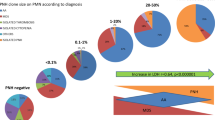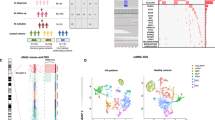Abstract
The presence of paroxysmal nocturnal hemoglobinuria (PNH) clones in aplastic anemia (AA) suggests immunopathogenesis, but when and how PNH clones emerge and proliferate are unclear. Hepatitis-associated aplastic anemia (HAAA) is a special variant of AA, contrarily to idiopathic AA, in HAAA the trigger for immune activation is clearer and represented by the hepatitis and thus serves as a good model for studying PNH clones. Ninety HAAA patients were enrolled, including 61 males and 29 females (median age 21 years). Four hundred three of idiopathic AA have been included as controls. The median time from hepatitis to cytopenia was 50 days (range 0–180 days) and from cytopenia to AA diagnosis was 26 days (range 2–370 days). PNH clones were detected in 8 HAAA patients (8.9%) at diagnosis and in 73 patients with idiopathic AA (IAA) (18.1%). PNH cells accounted for 4.2% (1.09–12.33%) of red cells and/or granulocytes and were more likely to be detected in patients with longer disease history and less severe disease. During follow-up, the cumulative incidence of PNH clones in HAAA increased to 18.9% (17/90). Nine HAAA patients newly developed PNH clones, including six immunosuppressive therapy (IST) nonresponders. The clone size was mostly stable during follow-up, and only 2 of 14 patients showed increased clone size without proof of hemolysis. In conclusion, PNH clones were infrequent in newly diagnosed HAAA, but their frequency increased to one that was similar to the IAA frequency during follow-up. These results suggest that the PNH clone selection/expansion process is dynamic and takes time to establish, confirming that retesting for PNH clones during follow-up is crucial.
Similar content being viewed by others
References
Young NS (2013) Current concepts in the pathophysiology and treatment of aplastic anemia. Hematology Am Soc Hematol Educ Program 2013:76–81. https://doi.org/10.1182/asheducation-2013.1.76
Bacigalupo A (2017) How I treat acquired aplastic anemia. Blood 129:1428–1436. https://doi.org/10.1182/blood-2016-08-693481
Zhao X, Zhang L, Jing L et al (2015) The role of paroxysmal nocturnal hemoglobinuria clones in response to immunosuppressive therapy of patients with severe aplastic anemia. Ann Hematol 94:1105–1110. https://doi.org/10.1007/s00277-015-2348-5
Wanachiwanawin W, Siripanyaphinyo U, Piyawattanasakul N, Kinoshita T (2006) A cohort study of the nature of paroxysmal nocturnal hemoglobinuria clones and PIG-A mutations in patients with aplastic anemia. Eur J Haematol 76:502–509. https://doi.org/10.1111/j.0902-4441.2005.t01-1-EJH2467.x
Narita A, Muramatsu H, Okuno Y et al (2017) Development of clinical paroxysmal nocturnal haemoglobinuria in children with aplastic anaemia. Br J Haematol 178:954–958. https://doi.org/10.1111/bjh.14790
Tutelman PR, Aubert G, Milner RA, Dalal BI, Schultz KR, Deyell RJ (2014) Paroxysmal nocturnal haemoglobinuria phenotype cells and leucocyte subset telomere length in childhood acquired aplastic anaemia. Br J Haematol 164:717–721. https://doi.org/10.1111/bjh.12656
Fattizzo B, Kulasekararaj AG, Hill A et al (2019) Clinical and morphological predictors of outcome in older aplastic anemia patients treated with eltrombopag. Haematologica 104:e494–e496. https://doi.org/10.3324/haematol.2019.216374
Fattizzo B, Levati G, Cassin R, Barcellini W (2019) Eltrombopag in immune thrombocytopenia, aplastic anemia, and myelodysplastic syndrome: from megakaryopoiesis to immunomodulation. Drugs 79:1305–1319. https://doi.org/10.1007/s40265-019-01159-0
Fattizzo B, Ireland R, Dunlop A, Yallop D, Kassam S, Large J, Gandhi S, Muus P, Manogaran C, Sanchez K, Consonni D, Barcellini W, Mufti GJ, Marsh JCW, Kulasekararaj AG (2021) Clinical and prognostic significance of small paroxysmal nocturnal hemoglobinuria clones in myelodysplastic syndrome and aplastic anemia. Leukemia. https://doi.org/10.1038/s41375-021-01190-9
Hill A, DeZern AE, Kinoshita T, Brodsky RA (2017) Paroxysmal nocturnal haemoglobinuria. Nat Rev Dis Primers 3:17028. https://doi.org/10.1038/nrdp.2017.28
Hu R, Mukhina GL, Piantadosi S, Barber JP, Jones RJ, Brodsky RA (2005) PIG-A mutations in normal hematopoiesis. Blood 105:3848–3854. https://doi.org/10.1182/blood-2004-04-1472
Brodsky RA, Hu R (2006) PIG-A mutations in paroxysmal nocturnal hemoglobinuria and in normal hematopoiesis. Leuk Lymphoma 47:1215–1221. https://doi.org/10.1080/10428190600555520
Gargiulo L, Zaimoku Y, Scappini B, Maruyama H, Ohumi R, Luzzatto L, Nakao S, Notaro R (2017) Glycosylphosphatidylinositol-specific T cells, IFN-γ-producing T cells, and pathogenesis of idiopathic aplastic anemia. Blood 129:388–392. https://doi.org/10.1182/blood-2016-09-740845
Zhang F, Zhang L, Jing L et al (2013) High-dose cyclophosphamide compared with antithymocyte globulin for treatment of acquired severe aplastic anemia. Exp Hematol 41:328–334. https://doi.org/10.1016/j.exphem.2013.01.001
Zhang L, Jing L, Zhou K et al (2015) Rabbit antithymocyte globulin as first-line therapy for severe aplastic anemia. Exp Hematol 43:286–294. https://doi.org/10.1016/j.exphem.2014.12.002
Lu J, Basu A, Melenhorst JJ, Young NS, Brown KE (2004) Analysis of T-cell repertoire in hepatitis-associated aplastic anemia. Blood 103:4588–4593. https://doi.org/10.1182/blood-2003-11-3959
Kojima S, Matsuyama K, Kodera Y, Okada J (1989) Circulating activated suppressor T lymphocytes in hepatitis-associated aplastic anaemia. Br J Haematol 71:147–151. https://doi.org/10.1111/j.1365-2141.1989.tb06289.x
Ikeda T, Morimoto A, Nakamura S, Yokoyama K, Hayase T, Oh Y, Kashii Y, Yotsumoto S, Okamoto H, Momoi MY (2012) A marked decrease in CD4-positive lymphocytes at the onset of hepatitis in a patient with hepatitis-associated aplastic anemia. J Pediatr Hematol Oncol 34:375–377. https://doi.org/10.1097/MPH.0b013e31822bf699
Osugi Y, Yagasaki H, Sako M, Kosaka Y, Taga T, Ito T, Yamamoto M, Ohara A, Sato T, Mimaya J, Tsukimoto I, Kojima S (2007) Antithymocyte globulin and cyclosporine for treatment of 44 children with hepatitis associated aplastic anemia. Haematologica 92:1687–1690. https://doi.org/10.3324/haematol.11359
Savage WJ, DeRusso PA, Resar LM, Chen AR, Higman MA, Loeb DM, Jones RJ, Brodsky RA (2007) Treatment of hepatitis-associated aplastic anemia with high-dose cyclophosphamide. Pediatr Blood Cancer 49:947–951. https://doi.org/10.1002/pbc.21143
Yang WR, Jing LP, Zhou K et al (2016) Hepatitis-associated aplastic anaemia: clinical characteristics and immunosuppressive therapy outcomes. Zhonghua Xue Ye Xue Za Zhi 37:399–404. https://doi.org/10.3760/cma.j.issn.0253-2727.2016.05.009
Wang H, Tu M, Fu R, Wu Y, Liu H, Xing L, Shao Z (2014) The clinical and immune characteristics of patients with hepatitis-associated aplastic anemia in China. PLoS ONE 9:e98142. https://doi.org/10.1371/journal.pone.0098142
Camitta BM, Thomas ED, Nathan DG, Santos G, Gordon-Smith EC, Gale RP, Rappeport JM, Storb R (1976) Severe aplastic anemia: a prospective study of the effect of early marrow transplantation on acute mortality. Blood 48:63–70
Bat T, Abdelhamid ON, Balasubramanian SK, Mai A, Radivoyevitch T, Clemente M, Maciejewski JP (2018) The evolution of paroxysmal nocturnal haemoglobinuria depends on intensity of immunosuppressive therapy. Br J Haematol 182:730–733. https://doi.org/10.1111/bjh.14862
Li Y, Wu Z, Zhao X et al (2016) Outcomes of very severe aplastic anemia patients with different absolute neutrophil counts after frontline immnunosuppressive therapy. Zhonghua Xue Ye Xue Za Zhi 37:329–333. https://doi.org/10.3760/cma.j.issn.0253-2727.2016.04.016
Funding
This study was supported by Grant 2017ZX09304024 of the National Science and Technology Major Project, by Grant 3332019094 of the Special Research Fund for Central Universities, Peking Union Medical College and by Grant 18JCYBJC41200 of Tianjin Manicipal Science and Technology Commission Grant.
Author information
Authors and Affiliations
Contributions
FZ served as the principal investigator for this study. WY wrote the paper and contributed to patient recruitment and statistical analysis. XZ, GP, LZ, LJ, KZ, YL, LY, YL, JL, HF, and YY contributed to patient recruitment and treatment.
Corresponding author
Ethics declarations
Ethics approval
This study was approved by the ethics committee of Blood Diseases Hospital, CAMS, and PUMC. All procedures followed were in accordance with the Helsinki Declaration of 1975, as revised in 2008. Patients provided written informed consent for data exploitation.
Conflict of interest
The authors declare no competing interests.
Additional information
Publisher's note
Springer Nature remains neutral with regard to jurisdictional claims in published maps and institutional affiliations.
Rights and permissions
About this article
Cite this article
Yang, W., Zhao, X., Peng, G. et al. Time and residual hematopoiesis are crucial for PNH clones escape in hepatitis-associated aplastic anemia. Ann Hematol 100, 2435–2441 (2021). https://doi.org/10.1007/s00277-021-04553-5
Received:
Accepted:
Published:
Issue Date:
DOI: https://doi.org/10.1007/s00277-021-04553-5




